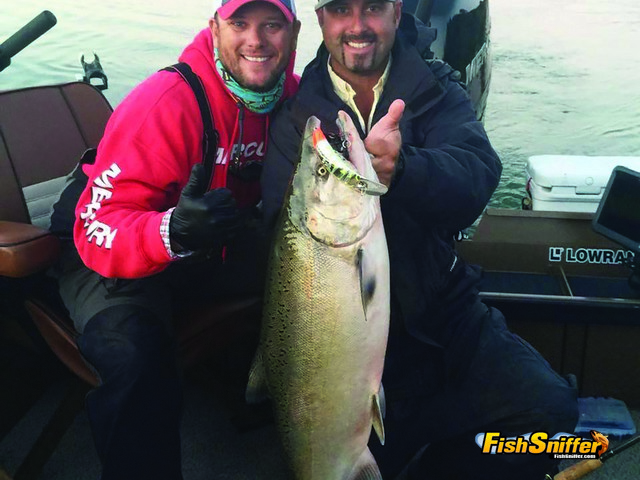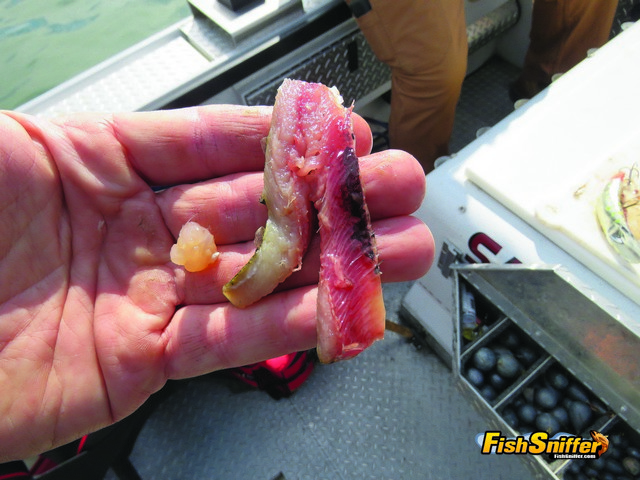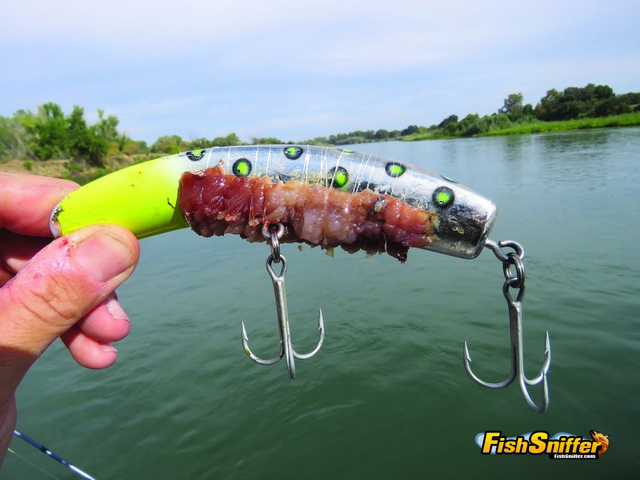Last time we looked at how to tempt river run kings with roe. If employing roe is “finesse” fishing, plugs definitely represent “power fishing” and that’s what we are going to focus on this week.
To understand plug fishing, it’s helpful to take a step back and ponder things from a broad perspective. River run salmon are typically doing one of two things. They are either pushing up river or they are resting. The salmon like to rest in specific locations and travel in specific lanes and they tend to be aggressive.
Okay, so there we have Mr. or Mrs. Salmon. Suddenly here comes a big bombastic plug vibrating and gyrating. The salmon are aware of the plug before they see it, but then it comes into sight. The plug gets closer and closer and pretty soon it’s right in the salmon’s face. The next thing you know that salmon lashes out, the hooks on the plug sink home and you’re glad you stocked up on chips for the smoker, ‘cause there is going to be some smoking going on!

The first thing we should do is define what a salmon plug is. Salmon might hit just about any sort of plugs some of the time, be it a Wiggle Wart intended to draw a strike from steelhead or a Rat-L-Trap tossed into the Sacramento River in hopes of tempting a striper.
For our purposes when I say salmon plug I’m talking about big banana shaped lures like Flatfish, Kwikfish and Brad’s Killerfish. There are several different variations to these kinds of lures. Some have rattles, some don’t. Some are designed to dive deep, some dive moderately. Yet they all have things in common. They all wobble violently and they all have a thick robust shape.
Just because you’ve got a selection of these plugs doesn’t mean they are ready to fish. Before you deploy them it’s standard practice to wrap them with bait (and swap out the hooks, but we’ll stick to the basics and gloss over hook changes and other tweaks).
When we talk about wrapping plugs we are generally talking about adding a small strip of sardine fillet to the belly of the plug, meat side out using elastic thread. Once the sardine is in place, most pro guides add a tiny bit of crawfish meat over the top. I’ve also seen guides wrap plugs with roe, roe and sardine and roe and crawfish meat.

The point of the wrap is to add scent to the lures. It’s thought that the smell of sardines is attractive to salmon because they spend a lot of time eating anchovies and sardines when they are in the ocean. The thought process on crawfish meat is that crawfish threaten the salmon’s eggs and they therefore lash out at a plug that smells of crawfish meat.
Plug fishing is mostly an approach for boaters, but there are a couple ways that bank anglers can effectively utilize plugs. I’ll touch on those toward the end of this piece, but we’ll get started with boat fishing techniques.
There are two basic ways to fish plugs from a boat. You can anchor up and allow the plugs to work in the current or you can back troll. Back trolling refers to using the boat’s kicker motor or in the case of a drift boat, the oars, to keep the boat moving downstream at a pace SLOWER than the current. When this is accomplished a plug in the water behind the boat will work against the current.
If the water is shallow, you can simply put a plug out behind the boat, whether back trolling or anchored, and the plug will dive down near the bottom where almost all the strikes occur. Salmon like to hang out and travel right along the bottom of the riverbed.
If the water is too deep to reach the bottom without adding weight, which is usually the case, you’ll need to employ a large enough sinker to get the plug down. This could mean using a one-ounce weight on an 8 ouncer depending on the depth and velocity of the water.
Regardless of the amount of weight used a three-way rig represents the basic set up. The three-way looks like this. Your main line (generally 65 pound braid) is attached to one eye of a three-way swivel. To the opposite eye a 48 inch 30 to 50 pound mono or fluorocarbon leader is attached and tipped with a plug. The third eye of the swivel gets a short section of mono tipped with a snap. This is where the weight attaches.
When fishing from the anchor, you’ll want to slowly spool the rig back behind the boat into the current. If you just drop the rig into the current, it will get tangled. You’ll want to release line until you feel the weight strike the bottom.
You’ll probably have to release line a couple more times before you get the plug positioned. Ideally once the plug is situated you should be able to lift the rod tip, raise the weight and then feel it hit the bottom again when you drop the rod tip. Once you’ve achieved this position. Simple put the rod in the holder and wait for a big ‘ol king to strike.
Back trolling is a little more complicated and angler involved. Your goal when back trolling is to continually and slowly lift and lower the rod tip, lifting and lowering the sinker. In this way you “walk” the sinker downstream foot by foot. Without all this lifting and lowering your sinker will quickly become wedged in the rocks.
Before I touch on hook-sets, I’ll speak a bit about presentation. In general, you can’t present a plug just anywhere in the river and expect to hook up with any kind of consistency.
If you are going to fish from the anchor it’s critical to position your boat in such a way that your plug is working in a seam, pinch point or other area that is going to cause the salmon to funnel by. Not every fish is going to hit. It’s like getting a date with a pretty girl. The more girls you meet the better your chances of getting a date.

When back trolling, the person running the kicker motor positions the plugs. It may be a travel seam that is being explored or an area where resting fish are suspected to be hanging out. In either case, it’s the guy on the motor that is doing most of the “fishing”. The anglers on the rods are more in the execution business. They work the plugs, keep them out of the rocks and set the hooks when a fish strikes.
Now salmon have a soft mouth and most salmon plugs bristle with big ultra-sharp treble hooks. You’d think that any salmon that hits would almost certainly get hooked…Not quite!
Salmon hit plugs hard and anglers tend to set the hook much too quickly. For the best results, whether you are fishing with the rod in your hands or in a holder, the best course of action is to let the fish maul the lure for two, three or more seconds before rearing back. You want that plug deeply into the fish’s mouth when you make your move.
And when you do set the hook, set it HARD. Remember, you’ve got current and likely a sinker to deal with and if the salmon is really clamped down on the plug you’ve got to break the plug lose for the hooks to sink home.
What’s the best plug color? They all work, but two favorites are chrome with a chartreuse butt and pearl or pearl with a bit of pink.
In closing I’ll toss out a couple tips for the bank guys. You can really employ plugs two different ways. If the water is shallow and quick you can utilize an inline side planer to guide a plug out into the current.
Even more interesting is a technique known as “plug plunking”. This approach is mainly used in deep water areas that feature a robust current. Here’s how it works. Take a stout spinning rod spooled with 65 pound braid and knot on a swivel. To the swivel tie on a 24 inch section of 15 pound test and tip it with a 6 or 8 ounce pyramid sinker. Set the rod aside for a moment.
Grab a wrapped salmon plug and attach it to a 48 inch 40 pound test leader and tip the leader with a snap swivel.

Grab the rod and cast it into the river. Once the sinker hits bottom drag it along until it catches on the rocks. Most of the time the sinker will snag and you’ll never recover it. With the sinker holding fast put the rod into a holder and reel the line taught.
Now snap the plug/leader onto your main line and toss it into the water. The pressure of the current with cause the plug/leader to walk down until it wedges against the swivel at the end of the main line. Once that happens you should be able to clearly see the plug working on the tip of the rod.
At this point all it takes to hook up is plenty of patience. When a king takes the plug, set the hook hard and the sinker should snap off. In this way you’ll be able to fight the fish unimpeded!
[embedyt] http://www.youtube.com/watch?v=iLwqx8aMnsA[/embedyt]
